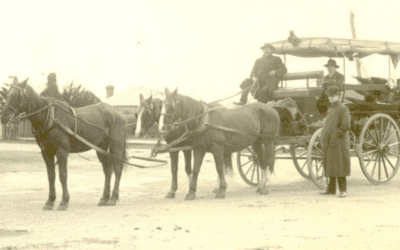In the freight industry, overall success for a business relies heavily on efficient operations and constantly being prepared for consumer trends. When companies maintain a tight schedule to keep up with the peak season, having an effective process that predicts trends, customer demands, and market shifts makes a smoother system of operations from start to finish.
In peak season, getting in-demand products out quickly to the end consumer is vital, especially if the product is on everyone’s holiday wish list. During the holidays, it’s typical to see things flying off the shelf, but who puts it on the shelf in the first place?
Transportation companies work around the clock to ensure goods are store-ready during the holiday shipping season. From August to November, the average volume growth during peak season for transportation industries grows at least 10% to 15%, so ensuring the product reaches the end consumer is incredibly important for business success.
Peak Season Checklist
The peak season for transportation is usually around the months leading up to the holiday season when there is a high demand for shipping goods as businesses start pushing products for the holiday rush.
During this time, businesses continuously deal with increased order volumes, tighter delivery deadlines, and fluctuating demands. On top of that, millions and millions of packages are being delivered daily.
It may seem easy to fulfill holiday demands from the consumer’s eye, but that’s not always the case. Preparation comes months in advance, logistics freight rates have increased demand and limited capacity, ports are usually congested, and driver shortages could lead to delays in shipping. If businesses don’t stay on a tight schedule and let issues fall through the cracks, it could be detrimental to them.

The Time to Start is Now
There are 4 primary shipping seasons for consumers:
- Q1: The Quiet Season
Typically, the quiet season follows after the holiday season, falling between the months of January to March. Due to the winter weather and the post-holiday slowdown, this is the slowest time of the year for trucking. Freight volumes are down, and capacity is abundant, making it easier to find available trucks at lower rates.
- Q2: The Produce Shipping Season
Produce shipping starts in April and lasts until July because most shipments are fruits, vegetables, or other perishables. Demands for reefers increase as consumers start to stock up on fruits and vegetables for the summer.
- Q3: The Peak Shipping Season
This is the busiest time of year for shipping as businesses prepare for the holiday season. From August to October, many retailers begin positioning holiday freight for the holiday season. Preparation for back-to-school items and office supplies is also in full swing. Typically, the types of modes transporting these items are vans, flatbeds, and reefers.
- Q4: The Holiday Shipping Season
While this is the shortest season of the year, it’s also the busiest! Consumers buy for the holidays from November to December, and businesses meet those product demands. Companies rush to get freight out before holiday closures, including last-minute orders.
Commodities from Start to End
The supply chain can primarily affect seasonality, and the demand for commodities increases significantly. During peak season, an increase in commodities can lead to congestion in the transportation network, which can also cause delays and increased costs.
Medical Supplies
Medical supplies are in demand year-round, which creates a peak season depending on the product type and what transportation requirements it may have. In 2019, The Council of Supply Chain Management Professionals (CSCMP) found that demand for medical supplies increases by 25% to 30% during peak season, which can be detrimental to supply chains.
Businesses that need to ship pharmaceutical products will find their peak season to be around December to February. Therefore, it’s essential to understand what products are being shipped so businesses can transport them accordingly. Typically, late winter and early spring are the best when shipping pharmaceuticals in peak seasons. Since demand is at its lowest during this time, shipping will ensure businesses will avoid delays or other problems later in the year.
Consumer Goods
For consumer goods such as electronics, clothing, and toys, suppliers will stock products that will sell during the holiday season. Suppose big-box stores are pushing specific items like game controllers or trending toys. In that case, it’s the store’s job to relay this information so businesses can get the shipments ready before the holidays.
In 2021, U.S. retailers lost $82 billion in CPG sales because of high consumer demands and out-of-stock items. E-commerce goods also experienced an increased volume of sales but ultimately didn’t prepare for consumer demands.
Tackling Peak Season
Manufacturers faced many supply chain disruptions due to the Covid-19 pandemic. Over 82% of companies have experienced unplanned downtime during peak season for the past couple of years. After the pandemic, 90% of companies felt more prepared to meet customers’ demands going into peak season than in 2020. During this period, consumer spending was high, and companies were still profiting from holiday spending.
But where will 2023 stand in comparison to previous years? Unfortunately, we aren’t seeing positive signs for peak season due to the economic status in the United States. Demand this peak season is reflected by rates and supplies. While many carriers implemented General Rate Increases (GRIs) to stabilize the market. But with each rise comes a corresponding dip – having low rates doesn’t guarantee stable rates.
With rates in mind during this season, there may be a more significant number of blank shipments going out to break even on the supply versus the demand number.
Challenges Face Opportunities
Peak season is a challenging time for industries but can also be seen as a time of opportunity. Companies that are able to navigate peak season successfully can reap the rewards by understanding product demands and trends.
In the world of logistics and supply chain management, staying ahead of these trends is crucial. A logistics company shipper needs to embrace e-commerce and understand e-commerce growth projections. The e-commerce industry, with its online shopping surge, directly affects commodities markets and commodities prices.






